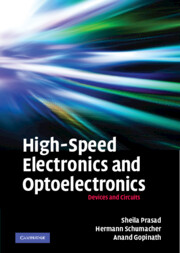2 - Electronic devices
from Part One - Devices
Published online by Cambridge University Press: 05 August 2012
Summary
Executive summary
This chapter introduces the active devices commonly used in high-speed electronics. It starts with a discussion of the metal–semiconductor field effect transistor, or MESFET – historically the oldest FET concept, which for decades was the most prominent device in microwave electronics. Its pitfalls led to the development of an advanced transistor structure, the high electron mobility transistor (HEMT). It incorporates heterostructures to gain additional freedom in device design. HEMTs mostly replaced MESFETs in micro- and millimetre-wave applications.
Metal-oxide-semiconductor field effect transistors (MOSFETs), which dominate digital electronics, are rapidly making inroads at microwave and even millimetre-wave frequencies. They will be discussed as well, and we will recognise similarities between HEMTs and MOSFETs in the physics of the intrinsic transistor.
Finally, bipolar junction transistors (BJTs) will be introduced, showing how a dilemma in the optimum design of the base layer led to the invention of the heterojunction bipolar transistor (HBT) – again, heterostructures come to the rescue. For all these components, the chapter will discuss their fundamental physical operation, non-ideal and parasitic effects, and linear and non-linear models, as well as examples in several material systems.
MESFET
Introduction and current control mechanism
The metal–semiconductor field effect transistor (MESFET) is conceptually the simplest of the commonly used transistor structures and shall therefore be discussed here first.
- Type
- Chapter
- Information
- High-Speed Electronics and OptoelectronicsDevices and Circuits, pp. 46 - 162Publisher: Cambridge University PressPrint publication year: 2009
- 1
- Cited by



